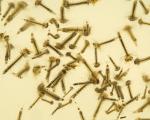Purulent discharge from a spayed cat. Causes of white, purulent and bloody discharge from the cat's vagina
In cats, spotting can be both a variant of the norm and a sign of serious illness. In the first case, they accompany normal physiological processes, such as estrus or cleansing of the uterine cavity after childbirth. But if the discharge appears at the wrong time, causes discomfort to the pet and has a fetid odor, you need to consult a veterinarian as soon as possible. If this is not done, the animal may die.
So, how to distinguish normal from pathological discharge and how to treat a cat?
Reasons for the appearance
Normally, spotting occurs in a cat for the following reasons:
- Estrus. Allocations indicate that the cat is ready to mate and bear offspring, their duration is several days. At the same time, the secret does not have an unpleasant odor, and the animal, licking itself, does not leave marks on surrounding objects. It is important to remember that spotting during estrus is typical for undecoupled cats. After the first birth, they will always be transparent.
- During pregnancy. Normally, the entire period when a cat is carrying offspring, she should not be bothered by discharge. The ichor can stand out during contractions.
- after the birth of the kittens. The body of the animal is recovering, therefore, during the first three weeks after childbirth, the presence of spotting is considered the norm. At the same time, the pet should feel good, eat as usual and carefully care for the offspring. If the discharge continues for more than the specified period, and the cat becomes lethargic, then it must be shown to the veterinarian.
A small amount of blood from the uterus can be excreted in cats only for the reasons described above. If the secret is profuse, foul-smelling, or includes particles, then this may be a symptom of many diseases of the genitourinary system or a sign of uterine bleeding.
Dangerous diseases
Cats may experience unusual spotting, which are symptoms of the following diseases:
- endometritis and pyometra - diseases of an infectious nature, in which the uterine mucosa becomes inflamed and begins to bleed;
- inflammatory processes in the genitals - their causes are diverse, ranging from stress to infection, often ending in cystitis;
- phlegmon - under the influence of adverse factors, the cat has swelling of the genital organs and the formation of expressions;
- vaginitis - inflammation of the vagina caused by infections or injuries after unsuccessful medical procedures;
- the tumor process in the uterus - as a rule, is malignant in nature, the animal has destruction of soft tissues;
- placenta in the uterus - if not all afterbirths came out during childbirth, this leads to an inflammatory process in the uterus;
- various injuries of the genital organs - most often the cause is a poorly performed operation, which leads to bleeding.
The above diseases have many similar symptoms:
- the animal becomes lethargic, drowsy;
- the cat tries to hide from the owners and other pets, does not show interest in the game;
- there is a refusal to eat, the animal may not drink well;
- a secret is secreted from the genital organs, which, depending on the pathology, can be fetid, with traces of pus and particles of the mucous membrane;
- blood loss continues for a long time without a tendency to stop;
- the animal's temperature rises and does not subside.
To find out exactly what the pet is sick with, you need to contact your veterinarian as soon as possible. Trying to find out exactly what is happening with the cat on your own will not only fail, but will also waste valuable time.
Treatment
Before starting to treat the animal, the doctor finds out the root cause of the discharge. This will require the following examinations:
- primary examination of the animal, careful palpation of the abdominal region;
- general and biochemical analysis of blood, laboratory analysis of urine;
- Ultrasound of internal organs;
- examining the uterus with a colposcope;
- study of secretions;
- bakposev to identify the pathogen;
- biopsy of the mucous membranes of the genital organs.
According to the results of the research, the doctor makes a diagnosis and prescribes the necessary medications and procedures.
Depending on the cause of the bleeding, the cat is prescribed the following treatment:
- Antishock therapy is carried out with the help of painkillers.
- If your cat is bleeding heavily, a blood transfusion may be needed.
- If bleeding is caused by low blood clotting, then corrective therapy is prescribed.
- For pathologies such as tumors or endometritis, surgery is indicated followed by chemotherapy to reduce the risk of relapse.
- The animal is prescribed antibiotics when the disease is caused by pathogens.

All drugs and their dosage can be prescribed and adjusted only by a veterinarian. Self-medication will not only not bring a positive result, but can also lead to the premature death of a pet.
Care, maintenance and treatment of your pet
In order for therapeutic measures to bring positive results sooner, the owners need to provide the cat with proper care:
- Equip the animal with a secluded place, put a disposable sheet on the couch and change it regularly as it gets dirty.
- The room where the sick cat is located should be warm and not drafty, and it must be regularly ventilated.
- For the duration of treatment, it is forbidden to let the pet out on the street, it should limit its communication with other pets.
- The cat must have constant access to drinking water. If the animal refuses to drink or is too weak, you must water it yourself with a syringe, after removing the needle.
- During the illness, the animal should receive nutritious and easily digestible food. These can be meat broths, to which minced meat, dairy products, cereals and vegetables are added in small quantities. On the advice of a veterinarian, you can purchase special medicated food so that the animal gains strength faster.
To protect your pet from the occurrence of diseases that lead to bleeding, you must adhere to the following preventive measures:
- If the cat is not intended for breeding work, it makes sense to sterilize the pet. This will save her from many diseases that occur in the genitourinary system. After the procedure, the cat should be regularly shown to the veterinarian for an ultrasound, this will help to better monitor the health of the animal.
- Timely do all the necessary vaccinations and carry out antihelminthic treatment to maintain the body's defenses.
- For mating, choose a healthy cat, the owners of the male must document this.
- During childbirth in a cat, use sterile consumables, carefully treat hands with antiseptics.
- Any unusual discharge should be taken to the veterinarian as soon as possible.
The above measures will help not only prevent the development of the disease, but also, if necessary, show the cat to a specialist as soon as possible without wasting time.
Bloody discharge, accompanied by a significant deterioration in the condition of the animal, is a formidable sign indicating the development of severe pathology. You do not need to try to find the cause yourself, but take the cat to the veterinarian as soon as possible for examination and treatment.

Discharge from a cat can be represented by liquid substances, which do not include urine. They mostly appear on the external genitalia. It is worth noting that the discharge can be bloody, gray, cloudy and even watery.
It is important to notice this phenomenon in time. In some cases, this is not a big deal. But often the discharge indicates that the animal has health problems. And they can be of any nature. In any case, the cat should immediately be shown to the veterinarian in order to exclude the most unfortunate outcomes. There are several main reasons why a cat has discharge.
So, first of all, this phenomenon can be considered normal only if it occurs in the postpartum period. Moreover, it is important to pay attention to the color, so dark green and brownish-red discharge should not cause concern to the owners of the animal. After all, we are talking about the recovery period after childbirth, it usually lasts 3 weeks. Sometimes discharge appears in cats during estrus, if it is "untouched" by the cat. This phenomenon is observed for several days and does not pose any danger.
Moreover, this phenomenon is quite difficult to distinguish from blood in the urine. Therefore, diagnosing something on your own is difficult, and indeed dangerous for the life of the animal. If the cat suffered a trauma of the vagina, then bleeding may accompany her throughout her life.
The color of the discharge during this period can be from dark green to black. As in the previous case, all this is stored for 3 weeks. If we are talking about the period of pregnancy, then any discharge from cats at this time is dangerous. You should not wait and hope for the best, you need to take the animal to the vet. So, all of the above is among the harmless phenomena, then we will talk about more serious cases.
Urogenital infections are often accompanied by discharge from the urinary tract. They may be pinkish or even opaque. In the latter case, we are talking about a purulent infection. Most likely, the animal develops pyometra, it must be dealt with immediately. This disease is a serious tumor. Pyometra in a cat must be removed in time so that it does not lead to death.
The next reason for the discharge may lie in cancer of the urogenital tract. With this phenomenon, the discharge is reddish or purulent. They mostly appear in the vaginal area. Pulling and self-medication is prohibited, you should immediately provide qualified assistance to the animal. Often, mucous secretions signal the presence of vaginitis. This disease is fraught with serious consequences. It is an inflammation of the vagina, in which you need to act immediately. A clotting disorder results in abnormal bleeding.
It is important to recognize the discharge in time, because for some reason many owners do not attach any importance to this. Ultimately, the animal suffers and ends in death. Obviously, you don’t want to lose your pet due to inattention. Therefore, you need to know some information. In particular, about the most terrible diseases, such as pyometra.
But if we are talking about pus, then you should consult a doctor. What is pyometra in cats and how to deal with it correctly? By the way, if the injury was “removed” by an experienced specialist, then you should not worry. Otherwise, more serious problems may arise. Sometimes animals have an incorrect location of the ureter or some problems with the sphincter. In this case, there is a discharge, the cause of which is the pooling of urine in the vagina.
Such a "combination" promises constant irritation, from where, in fact, everything happens. Sometimes cats have some defects in the rectum or fistulas. Therefore, watery feces are carried along these channels through the intestines to the vagina. This is where the weird stuff comes from. In any case, whatever the nature of this phenomenon, you need to fight it. You should not wait until the situation changes by itself, this can lead to serious consequences and the animal can eventually die.
If you do not deal with this issue in time, you can be left without a pet. Pyometra in cats, which is not so easy to treat, is often found in these animals. Therefore, if any discharge appears, you should immediately contact a specialist.
Cats often experience vaginal discharge. There is nothing to worry about if the animal has started estrus or the body has not yet fully recovered from childbirth. But if a cat, especially a sterilized one, has discharge that does not stop for a long time, has a pungent odor, a strange color, or inclusions of unknown origin, then this may indicate the development of various pathological conditions. Most often, the appearance of secretions is provoked by inflammatory processes and tumors.
Kinds
The cat constantly licks itself, so it is not so easy to notice the appearance of discharge. If the discharge from the genitals became too abundant, the animal stopped “washing”, this is an occasion to watch the animal more carefully.
Discharge from the uterus in a cat is of two types: natural and life-threatening, caused by disease or injury.

natural
Natural secretions appear:
- During the flow. They mean that the cat is ready to mate with the male. They continue for several days. At this time, the behavior of the cat changes. The animal becomes more excited, tries to play and fight with the owners or other animals, arches its back, raises the back of the body. Allocations during estrus are homogeneous, without inclusions, transparent color. They don't smell.
- After childbirth. Normally, discharge should be observed no more than twenty-one days after lambing. During this time, the cat's body is completely restored. The first few days after delivery, the discharge may be reddish or brown, flecked or streaked with green, and has a metallic odor. The behavior of the animal does not change, the appetite remains good, the cat is cheerful, fully cares for the kittens. If the discharge continues for longer, the animal becomes lethargic and refuses to eat, this is a reason to go to the veterinarian. Such symptoms may indicate a birth injury or an infection in the body.
- During pregnancy. During gestation, a cat may excrete fluid or mucus until the third week and 24 hours before the onset of labor. In the first case, it will be transparent, odorless, viscous discharge, which indicates the beginning of the formation of a mucous plug. Before childbirth, the mucous plug departs, yellowish discharge appears, which during the period of labor is replaced by bloody. Between the fourth and eighth weeks of pregnancy, there should be no discharge.

Dangerous
The appearance of some secretions requires attention and prompt assistance. They can be provoked by:
- The development of a malignant tumor. With cancer, purulent discharge with a fetid odor comes from the uterus. They indicate the destruction of soft tissues. Treatment of pathology at home is impossible, you should immediately consult a doctor.
- Decomposition of the placenta. Sometimes after childbirth, the placenta does not come out completely. The cat begins to behave sluggishly, watery discharge with bloody clots appears from under the tail. Needs to be cleaned at the veterinary clinic.
- Uterine trauma. The animal can get injured if the surgery is unsuccessful. In this case, the discharge from the anus is profuse, contains a large amount of blood. The cat needs to ensure complete rest, keep other animals away. Put the bed in a separate room. It is impossible to determine the nature of the injury on your own, the help of veterinarians is required.
- Inflammation of the genitals. Occurs for various reasons: with hypothermia or with infection after childbirth. The cat often licks, she has frequent painful urination. Often, the infection enters the bladder, which leads to cystitis. It is necessary to protect the cat from drafts, do not let it out into the street. If infections are found in the urine, a course of antibiotic treatment should be given.
- Vaginitis. The acute form of the disease may be the result of trauma during childbirth. Chronic vaginitis occurs as a complication after serious diseases, such as chlamydia. Vaginitis comes in many forms. With serous vaginitis, the discharge is cloudy, transparent, accompanied by the appearance of ulcers on the soft tissues of the vagina. Catarrhal-purulent vaginitis is characterized by cloudy yellow or white discharge and inflammation of the area under the tail. If left untreated, vaginitis will progress to other conditions such as cystitis and endometritis.
- Phlegmon of the vagina. The genitals of the cat swell, ulcers appear on them. The animal's temperature rises and there are purulent discharges with pieces of dead mucosa.
- Endometritis. During this disease, the mucous membrane of the inner surface of the uterus becomes inflamed. The causes of the disease are varied, but most often it is a sexually transmitted infection and a side effect of drugs that cause suppression of desire. Allocations with endometritis are spotting, abundant, with an admixture of blood. The cat becomes in a pose, as if preparing to urinate, meows and arches its back.
- Pyometra. This is one of the forms of purulent endometritis. It is only safe for a neutered cat that has had its uterus and both ovaries removed during spaying. The main causes are hormonal problems, which are most often caused by drugs against desire, and not completely cured endometritis. The cat is feeling unwell, lethargic, white discharge from the vagina appears.


You have a cat at home, you take care of it, nurture and cherish it, perhaps take it with a cat. And after a visit to the cat, you noticed some discharge. Are they normal or not. Let's figure it out.
What discharge is normal and what is not?
What is the difference between natural secretions and painful ones? And what causes these discharges? What is meant by the concept of normal discharge is such discharge that occurs in cats during pregnancy, during the birth of cats, and the postpartum period. If such discharge appears, then there should be no cause for concern. The main cause for concern should be painful discharge, for example, with endomitritis, pyometra, vaginitis, vaginal tumors. Let's look at some of the diseases that cause bleeding from the cat's vagina.
Pyometra in cats
This disease is caused by the accumulation of pus in the uterine cavity. There are open and closed forms of pyometra. Less dangerous is open pyometra, the discharge is purulent and comes out of the genital loop. The most dangerous closed form of pyometra, there is no discharge at all, since all the pus accumulates in the uterus, which can be fatal.
Vaginitis in cats
This is a disease of the vagina accompanied by inflammation. Signs: discharge and frequent licking of the perineum.
How to identify painful discharge? What are the signs of bad discharge?
You may not even notice the discharge itself, since the cat is a very clean animal. Therefore, every breeder should be aware of the signs of bad discharge in a cat. The main thing is to pay attention to the frequency of licking the perineum by a cat, if within 5-15 minutes, sound the alarm. In addition, watch the cat's appetite, if you have a poor appetite, lethargy, frequent urination, sound the alarm. And do not pull, contact the veterinarian. Better than a veterinarian and a complete examination (ultrasound, x-ray, blood test), no one can determine whether the discharge is good or bad. After everything done in the veterinary clinic, the doctor will prescribe either
Cats occasionally experience vaginal discharge, which is of little concern to owners. The discharge may be watery, clear, bloody, yellow (purulent), dark green, or brown (postpartum). In this case, the animal periodically licks the causal place, but no other changes in behavior are observed. Let's try to figure out why a cat has vaginal discharge and how it can be cured.
Causes of discharge from the vagina in a cat
Several factors come into play here:
- Discharge from a pregnant cat. If they have a reddish tint, then this is a potential threat of miscarriage. In the postpartum period, the presence of black and dark green discharge is natural and can last for several days. Traces remain up to three weeks. If the placenta has not gone, then there are abnormal bloody and watery discharge.
- . At the age of more than five years, unneutered cats may begin to accumulate pus in the uterus, which can lead to bloating and pus in the abdominal cavity. Discharge of pus is observed in the open form of the disease. The purulent contents are brown, pink or cream in color.
- Vaginitis. Occurs on the basis of an endocrine disorder with the participation of an infection (streptococcus, E. coli, staphylococcus aureus). With vaginitis, a cat has a creamy white discharge. The inflammatory process is treated with douching or oil emulsions.
- endometritis. Inflammation of the lining of the uterus begins with small, spotty discharge from the vulva, which becomes profuse and foul-smelling over time. Endometritis is treated with antibiotics, antimicrobial and hormonal drugs.
Thus, if a cat has discharge during or after



